The 7th Annual Demographia International Housing Affordability Survey has just been released and, once again, it has delivered a stern condemnation of housing policy in Australia.
This year, the Demographia survey has been expanded to 325 markets in seven countries: Australia, Canada, Hong Kong, Ireland, New Zealand, the United Kingdom, and the United States. The survey employs the “Median Multiple” (median house price divided by gross annual median household income) to rate housing affordability. This measure is widely used for evaluating urban markets, and has been recommended by, amongst others, the World Bank and the United Nations, and is used by the Harvard University Joint Center on Housing.
The Survey ranks urban housing markets into four categories based on their Median Multiple, from “Affordable” (3.0 or less) to “Severely Unaffordable” (5.1 & Over) [Table ES-1].
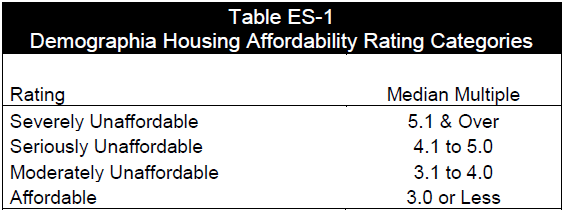
According to the Survey, Median Multiples were historically 3.0 or less in Australia, Canada, Ireland, New Zealand, the United Kingdom and the United States. Whilst this affordability relationship continues in many housing markets of the United States and Canada, the Median Multiple has escalated sharply in the past decade in the other housing markets covered in the Survey (Table ES-4).
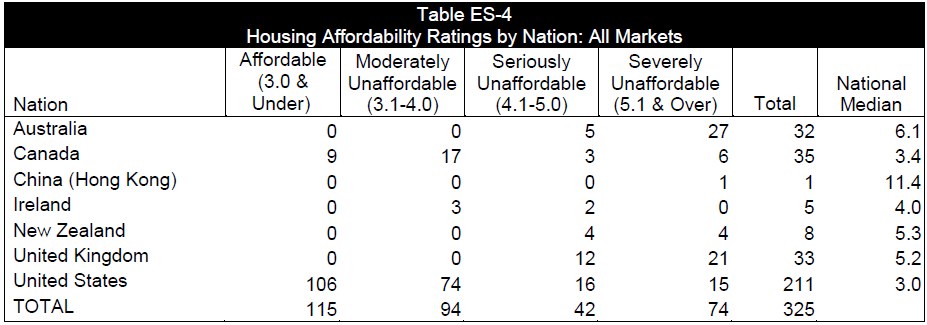
Demographia’s findings are supported by the below chart, which compares the total value of residential housing assets against GDP in Australia, Canada, New Zealand, the United Kingdom, and the United States (data is not available for Ireland). As you can see, Australia and New Zealand have the most expensive housing based on this metric (3.2 times GDP), followed the United Kingdom (2.9 times GDP). By comparison, Canada and the United States, which have more “Affordable” and “Moderately Unaffordable” housing markets, have house price to GDP ratios of only 1.8 and 1.1 respectively.
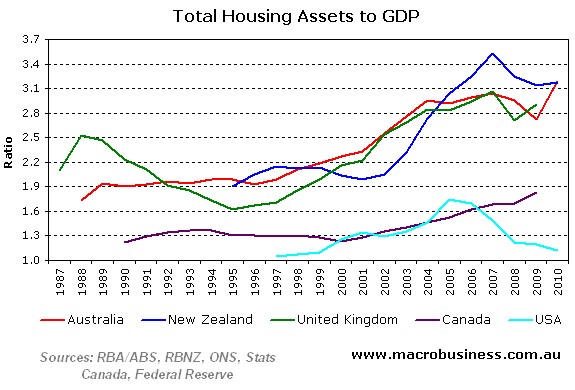
Of the 325 markets surveyed by Demographia, the lion’s share of unaffordable markets are located in Australia, with 27 ranked as “Severely Unaffordable” and five “Seriously Unaffordable”. Australia currently has no housing markets ranked as “Affordable” or “Moderately Unaffordable” (see below chart).
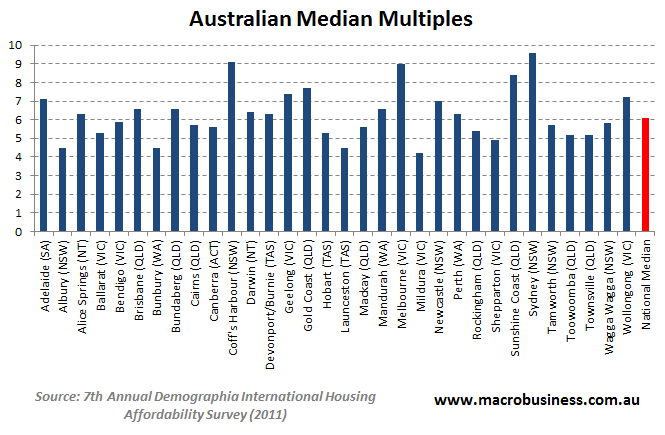
In fact, out of the 20 most unaffordable housing markets identified in the Survey, nine are located in Australia (see below chart).
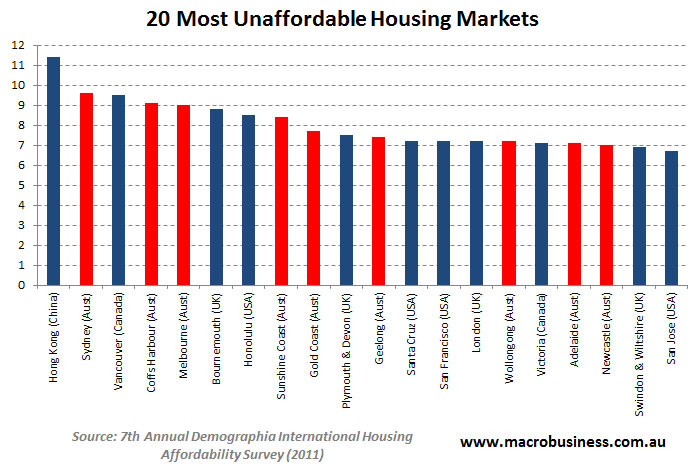
The decline of housing affordability in Australia is clearly evident from the below Demographia chart, which shows the escalation of Median Multiples in Australia’s major urban markets.
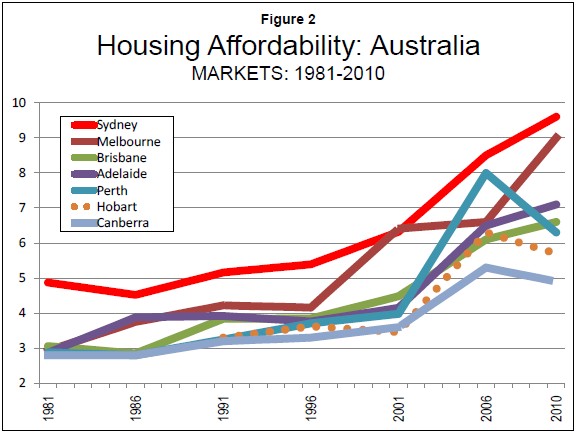
Whereas all major Australian markets, except Sydney, had Median Multiples of three in the early 1980s, today all are ranked at five or above.
Further, this deterioration of housing affordability has occurred without regard to market size or demand, with prices in slow growth areas such as Hobart and Adelaide, as well as regional areas, exploding over the past 15 years (see below RBA chart).
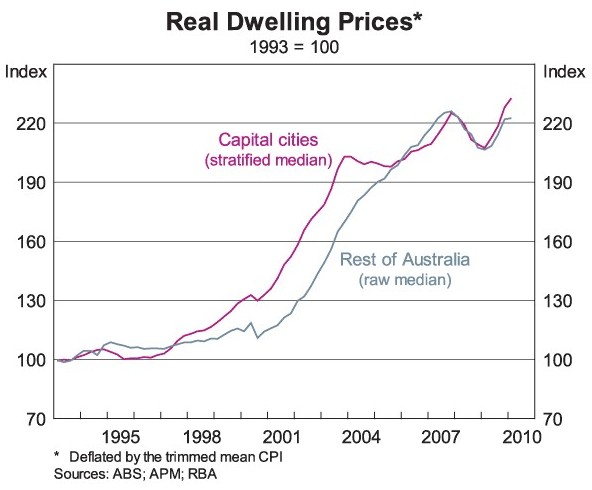
It’s all in the land:
The Demographia Survey makes a convincing case that:
…higher land prices are the principal contributor to the rapidly increasing home prices in unaffordable markets. These land prices include the cost increasing influence of land supply restrictions (such as urban growth boundaries), excessive infrastructure fees and other overly strict land use regulations. In Australia, 95 percent of the increase in inflation adjusted new house (and land) costs were attributable to land, rather than construction from 1993 to 2006. In more restrictively regulated San Diego, house prices were 250 percent higher than in Dallas-Fort Worth in 2007, yet cost only 15 percent more to build.
Again, Demographia’s contention is supported by evidence. As the below RBA chart shows, the lion’s share of the rise in Australia’s home prices has been due to rising land costs rather than higher building costs or incomes.
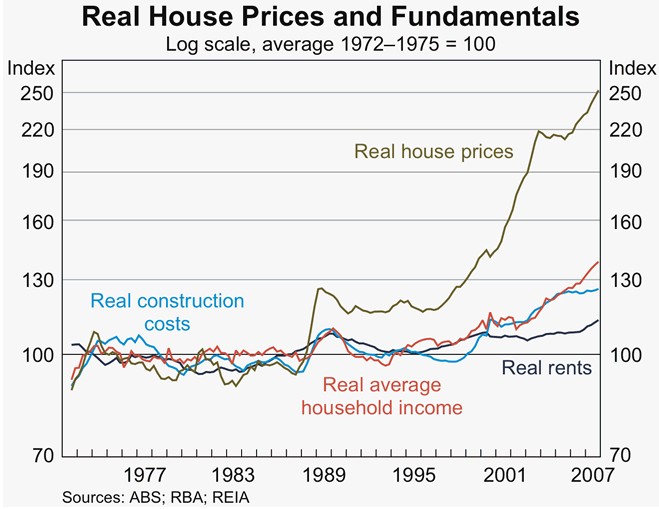
And a recent release from RP Data shows just how expensive fringe land has become in Australia, with blocks ranging from $145,000 in Hobart to $269,000 in Sydney. Amazingly, on a cost per square metre basis, Adelaide ties with Sydney for the highest cost land (see below table).
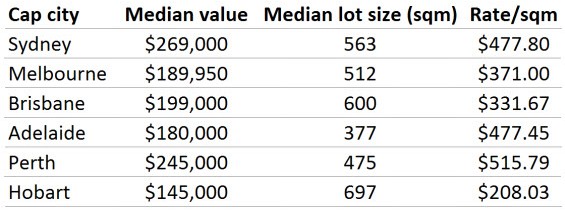
The key reason for this land price escalation in Australia (as well as in New Zealand and the United Kingdom) is that the market’s ability to quickly provide low priced new housing supply is being hampered by restrictive land use regulations, many of which have come into effect since the mid-1990s (Sydney has had long-standing limits on housing development on the urban fringe). Demographia describes the key features and consequences of restrictive housing markets as follows:
More Restrictive Markets rely on comparatively intrusive land use regulation, and include markets where residential development (new construction) is strongly controlled or driven by comprehensive plans or with extensive limits on development imposed at various levels of government. More restrictive land use regulation are also referred to as “compact development”, “urban consolidation”, “growth management” “and ” smart growth.” Generally, more restrictive land use regulation is “plan-driven,” as planners and governments determine where new housing is allowed to be built. As a result, there is a “negative presumption” with respect to development: Development is generally prohibited, except in limited areas where it is permitted by government plans. By severely limiting or even prohibiting development on the urban fringe, more restrictive regulation can make the “supply vent” inoperative where demand for new housing exceeds supply, which retards housing affordability…
House prices have skyrocketed principally because of more restrictive land use regulations that have virtually prohibited new house construction on or beyond the urban fringe. This is particularly evident where there are “urban containment” measures, such as urban growth boundaries. Land value differentials of ten or more times have been documented immediately across urban growth boundaries (such as in Portland and Auckland).
By contrast, affordable housing markets, like Texas and Georgia in the United States, utilise open market-based land use structures whereby plentiful new housing supply is able to be built quickly and cheaply on the urban fringe, thereby preventing rapid house price escalation. Demographia describes these markets as follows:
In these [less restrictive] markets, residential development is allowed to occur based upon consumer preferences, subject to reasonable environmental regulation. Generally, less restrictive land use regulation is “demand-driven”. There is a “positive presumption” that land can be developed, except in limited areas, such as parks and environmentally sensitive areas. By allowing development on the urban fringe, less restrictive land use regulation allows the “supply vent” to operate, which keeps house prices affordable.
So under an open market-based model, increased demand (e.g. from reduced lending standards) quickly leads to the building of additional low priced housing on the urban fringe, which keeps house prices in check and helps prevent speculative housing bubbles from developing. Further, highly leveraged speculators are not encouraged into open land use markets since there is little prospect of achieving strong capital gains. Investing, instead, becomes all about rental yield.
Demographia also provides a direct comparison of housing affordability in the more liberal markets of the United States versus Australia’s restrictive urban markets. The results are worrying.
The widening affordability gap between more restrictively regulated markets and less restrictively regulated markets is illustrated by comparable cases in the United States and Australia (Figure 3).
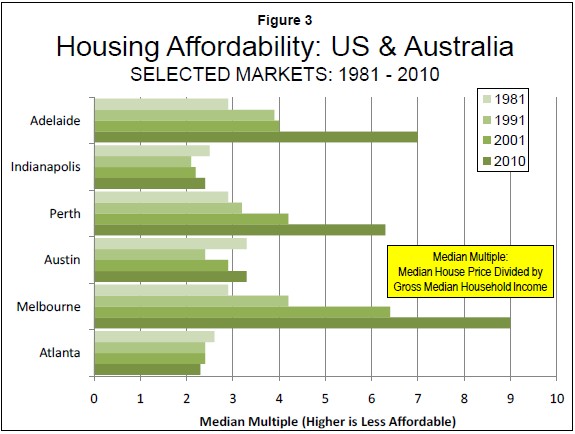
Generally, the three US markets (Atlanta, Austin and Indianapolis) have experienced price stability, with their less restrictive land use regulation (even during the US housing bubble). On the other hand, in Australia (and elsewhere in severely unaffordable markets) house prices have hyper-inflated, as more restrictive land use regulation has virtually outlawed new housing on urban fringes.
As a consequence, new large family homes can typically be provided in these open markets for only $150,000, with the land component comprising only around $30,000 (see here for details). This compares to Australia’s restrictive urban planning structure where capital city blocks of land typically cost between $145,000 to $270,000.
To make matters worse, Australia’s restrictive urban planning structure and housing affordability problems are not just confined to Australia’s capitals, but to our regional centres and towns as well:
… Severely unaffordable housing is even evident in the smallest markets with more restrictive land use regulation. This is illustrated by Wallan, Victoria an urban area of 5,000 people more than 10 miles (16 kilometers) beyond Melbourne’s urban fringe. Wallan is surrounded by land that could be developed, and which if the market of willing buyers and sellers were allowed to operate, could provide housing that is affordable.
…a new residential lot would cost $155,000 in Wallan, Victoria (Australia). This is approximately 5 times the cost of a lot for a new house inside (not 10 miles beyond) the urban fringe of Atlanta, Dallas-Fort Worth, Indianapolis or a number of other urban areas in the United States with less restrictive land use regulation. As a result of its high land costs that result from more restrictive land use regulation, the median multiple in Wallan is approximately 5.8, nearly double the affordable norm of 3.0.
Regular readers will remember that I wrote an article comparing the cost of homes in Wallan to Houston, Texas (the United States’ fourth largest metropolitan area). Included in this article was the following map, showing just how much plentiful land is available for building near Wallan if only regulations were permitting.
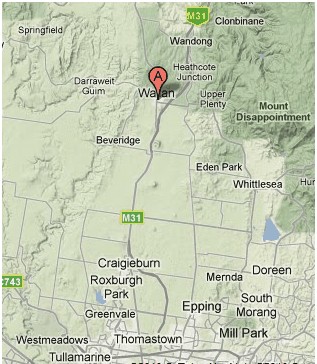
A problem of our own making:
The Demographia Survey proves, convincingly, that Australia’s housing affordability problems are caused, to a large extent, by artificial restrictions on where new homes can be built. When combined with demand-side drivers – such as easier credit (fuelled by heavy offshore borrowings by the banks), overly generous tax concessions (e.g. negative gearing), high immigration, first home owner concessions, and baby boomer wealth accumulation – Australia’s strict land use regulations have inevitably caused land prices to escalate, encouraging speculation and the development of Australia’s current housing bubble.
The big losers under this socially regressive system are younger and lower income Australians who are either required to take on prohibitive amounts of debt in order to enter the housing market, or are locked-out of home ownership altogether.
That said, property bulls should not necessarily view Australia’s restrictive urban planning structure as a bullish indicator for house prices. As explained previously, unresponsive housing supply merely results in greater house price volatility – both on the way up and the way down. Therefore, when the inevitable correction arrives, say through a contraction of credit or large falls in commodity prices, Australia’s restrictive urban planning structure is just as likely to cause large house price falls, similar to those experienced in the restrictive housing markets of the United States (e.g. California).
Cheers Leith

